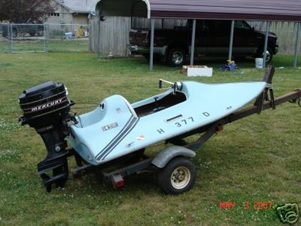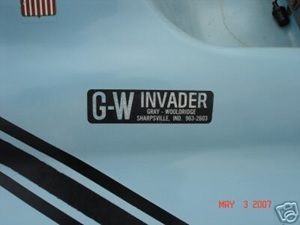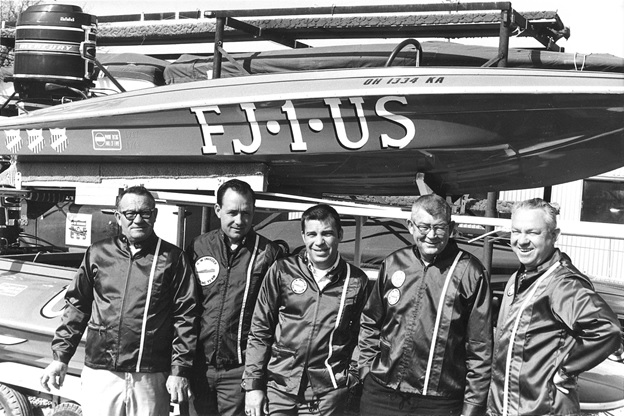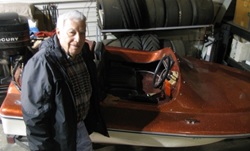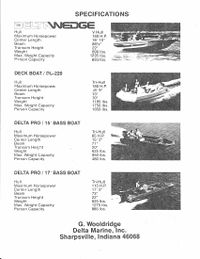Revision as of 19:31, 9 February 2014
THE STORY OF G-W INVADER
This is the story of G-W Invader. A small Midwest boat manufacturer that was made famous by its production of a small two seat sport boat simply called the “Ten-footer” in the late nineteen-sixties. This boat would fuel the imagination and passion of many young boaters at the time and it still has an incredible following nearly fifty years later. The company saw two main eras, driven by several important individuals whose contributions are highlighted in this approximate timeline. It’s a fascinating story not only about some great innovative boat designs, but also about the people who made it all possible and the highs and lows of their adventure. Their adventure was building high performance speed boats in a small Midwest farm town and having the time of their lives!
You cannot talk about G-W Invader without discussing its location as it adds to the interesting storyline. Sharpsville Indiana is located about 45 minutes directly north of Indianapolis just off state road 31. The nearest natural waterway is at least two hours away. The approach to town is not unlike most rural farm towns in Indiana, red barns with white trim, corn and soybean fields, the occasional tractor using up the road and shiny silver grain silos. Not until you got the faint smell of polyester resin in the air did you think something strange was going on here. Then, like an oasis in the middle of the desert, appeared a small factory surrounded by fiberglass boats. The company employed hundreds of people over its life span, many of which were simple farm folks who had never even ridden in a boat let alone built one. Nevertheless, this small boat company powered by innovative ideas and hardworking country folks made a name for itself in spite of its rural location.
G-W INVADER – The Wooldridge Era
George Albert Wooldridge – George was born in Sharpsville Indiana on May 10, 1919. He was raised by his aunt and uncle on the family farm, but did not long to be a farmer. Only sixty two short years later he would die from a heart attack, sitting at his desk, at the little boat company he loved so dearly. He was a product of the peaceful farmlands of north central Indiana who sought greater thrills in the art of building speed boats. He was always described as a genuine, kind, simple and honest man, almost to a fault. Blessed with inheritance of several hundred acres of prime farmland from his aunt, George had no interest in being a farmer and decided to put these assets towards a different career path. In the small rural town of Sharpsville and among the local Indiana marine industry, he was commonly called the “boat builder”. Although he had a trusted partner in Arnie Gray, the “G” in G-W Invader, it was no coincidence that most people believed G-W stood for George Wooldridge. He was the driving force behind the company for over two decades and quietly he helped produce one of the most popular boats of our time and an American icon. As seems fitting, George was buried in Sharpsville, only a few miles from the old plant, on June 9, 1981 after spending nearly twenty years doing what he loved.

– Although George was the financial backer of the new company, most considered Arnie the “designer” of the partnership. Not only did he pattern the legendary “Ten-footer” but he also pinned most of the literature and newsletters. His creative talent went far beyond boat design and he was simply brilliant in creating appeal for the G-W brand. Although he was not considered a salesman per say, his marketing of the boats through newsletters, decals, jackets, race teams, clubs, etc., he undoubtedly increased sales for the company. It has been said that Arnie was actually the motivation behind G-W Invader getting into racing, rather than George who eventually became addicted to the sport, as he saw the marketing potential that came from its success. He was described as a very quiet man, very well liked and often he kept to himself. Uninterested in mass production and business operations, he longed to be in the pattern room cutting and shaping the next design. Eventually he would hold multiple US patents for his inventions.
July 1963 – Looking for a home to rent for himself and his family in the summer of 1963, Arnie met George by sheer accident and eventually George became his landlord. As the two men became friends, talked about their backgrounds, work experience and dreams, a partnership was formed. George had the financial means and desire to be more than a farmer. Arnie had experience with fiberglass and more importantly was a good designer and marketer. It was the beginning of a perfect storm and a wild adventure for the two men. As the story goes, Arnie and George began their boat building adventure, with a small one seat craft, built for a local sporting goods distributor under the name of “Ski-bird”. At some point the “Ski-bird” name was dropped and the boats were rebranded with a G-W Invader decal.
With one glance, you can see the rough beginning of the legendary “Ten-footer” in the boat’s shape and lines. However, the boat could be very tricky to handle, even with only 20 horsepower.
Jan 1965 – Arnie Gray and George Wooldridge formed Gray-Wooldridge, INC. An early G-W News publication identified Arnie as President and George as VP. The factory was built on the west side of Sharpsville Indiana on land formally owned by George’s aunt, Mrs. Howard Umfreys and employed 25 people. From 1967 thru 1970 G-W Invader was at the pinnacle of success for the Wooldridge era. At some point in late 1965, Arnie designed and patterned the legendary “Ten-footer”. The boat’s simple clean lines hinted of a modern race boat, but it still had a fun, childlike, welcoming look to it. Larger than the Ski-bird, with space for two, it was safe with reasonable horsepower or could reach speeds of 50 mph plus with a motor of 55 horsepower. The boat’s only con was that it slid in turns due to its completely flat bottom, but was not noted for turning over. Soon after its initial production, a single pad was added to the hull to help, but the turning performance only slightly improved. The little boat had a remarkable durability for the constant beatings it took on the lake or even for the brave who took it out on the ocean. It was simple to build with cable steering, came in a multitude of wonderful colors from the 1960’s and was just plain fun to drive or ride in. To find a photo of a “Ten-footer” running or sitting without a glaring smile on its driver or passengers face is nonexistent. One can only speculate on how many adults today were impacted or affected by this fun little boat at that time.
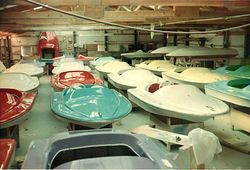
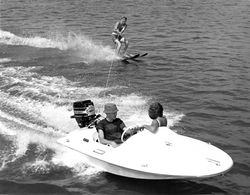
The legendary 10’-3” G-W Invader was put into production and for over half a decade the company manufactured thousands of the little boats. The boat became an immediate success based partially upon its unique styling and its low selling price, but more importantly on its ability to handle engines up to 55 hp.

This two-seat boat could generate adrenaline whether sitting still or racing across the water. Whether being owned by President Kennedy’s family or being put through its paces at such world famous ski shows as Cypress Gardens, the “Ten-footer” was the dream of every young boater. G-W Invader had literally created the personal watercraft in 1965! Many companies have made knock off copies of the original hull in attempt to profit from Arnie’s classic design, but none will ever be able to duplicate the magic the boat produced in the late sixties. Even today, nearly fifty years from its creation, a decent “Ten-footer” can command thousands of dollars for those looking to relive that childhood excitement. Not a week goes by that you will not see at least one for sale on the internet and the locations vary from Maine to California. This is a testament to how many were sold, how durable the boats were and how much they mean to people today, nearly 50 years after its creation.
The company’s first taste of racing came in 1967. The N.O.A (National Outboard Association) was looking for a safe, affordable, family friendly, starter class to entice new members and the Ten-footer fit the bill perfectly. There were four racing classes created for the “Ten-footer” by the N.O.A. The first “Invader” class was for youngsters of at least 12 (no minimum age if accompanied by an adult) years of age for stock engines with a maximum of 20 hp.
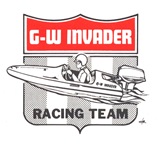
At the other end was a class for adults that allowed engines up to 55 hp! The fastest Ten-footers (model 103R) were usually equipped with a short shaft, four cylinder 50 hp Mercury outboard engine and were all manual start. Pull start engines did not require a heavy battery, starter or wiring and thus less weight for a faster boat. Today, finding a manual start 50 hp short shaft Merc from the late sixties with original factory “no start” controls is next to impossible. The boats were usually a single seat craft and included rally stripes and racing numbers. Speeds of 45 to 50 mph could be attained in the little race boat, but most describe the feeling as going 70 mph due to its size. Most dealers had a package deal where you could get the boat, motor, trailer and the works for around $1000. The company pushed hard through the G-W Invader News, flyers and dealers to get racing clubs started anywhere one was desired. Racing proved essential in increasing sales and giving the brand a solid identity in the market place.
Most dealers had a package deal where you could get the boat, motor, trailer and the works for around $1000. The company pushed hard through the G-W Invader News, flyers and dealers to get racing clubs started anywhere one was desired. Racing proved essential in increasing sales and giving the brand a solid identity in the market place.
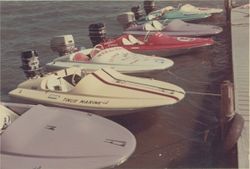
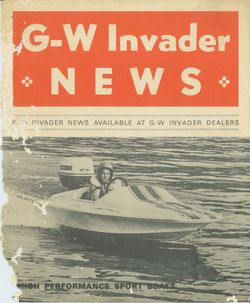
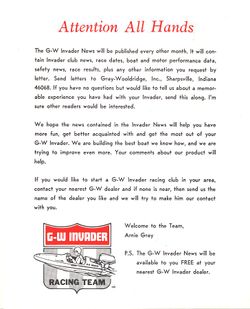
The company created innovative racing memberships and flyers touting young boaters to come join the G-W Invader racing team. The flyers offered items like membership cards, team badges, sew on patches, decals, T-shirts and jackets to promote the excitement of owning a “Ten-footer”. The G-W Invader News was published every two months and distributed to all the dealers. These wonderful little pamphlets offered normal insight on new models, optional equipment, dealer information, race schedules and news about the company and there was something more! Included were stories from young owners describing the “love affair” between the boats and their young drivers. On the inside cover, an introduction letter from Arnie Gray, welcomed young readers to “tell us about a memorable experience you have had with your Invader”. It was this simple marketing brilliance by Arnie, directed at young boaters that went beyond just owning the boat and promoted the special experience you would have by being part of G-W Invader team. In a letter to prospective dealers, G-W would provide “racing team” membership cards for dealers to hand out to kids, in turn kids would fill out the card for a membership badge. These membership badges, with the dealership name on them, were very successful in bringing in the parents of these kids to buy a boat. An article in Boat & Motor Dealer October 1966, called these kids “Junior salesman” and mentions “Boat dealers must be nuts, not to register every youngster in town from 3 to 80 years old as a member of the G-W Invader boat racing drivers club”.
July 1967 – As Arnie Gray’s role began to diminish at the company four important individuals were brought into the company to manage production, sales and the overall business. Their experience at a critical time in the young company’s life helped G-W survive its early success. Howard Alvey (holding the cigarette), a close friend of George for many years prior, was assigned VP of Production, Leon White was VP of sales, Bill Boice took the role of GM plus secretary-treasurer and Frank Roof was titled as VP of engineering.
Pictured above, Howard Alvey, Leon White, Bill Boice, George Wooldridge and Frank Roof with 1-US.
Bill Boice (Left, still owns his original Ten-Footer) - A native of Kokomo Indiana, Bill was initially hired as the General Manager and was responsible for overall production of the boat line. He was formally employed at Delco Electronics, a very large automobile components division of General Motors, before he took the job at G-W. The entire Boice family even got involved with the company. Bill’s wife Joyce even helped as the designated “gofer” at the plant and even traveled with Bill on weekends to far off places as the company supported the G-W race team. Even their daughter DeeAnna (better known as Dee), along with Joyce, can be seen on the cover of the second brochure showing off a red 19 foot Invader. Bill’s experience in mass production and business management was critical to the company in the late sixties. The proof is in the success the company had while sales sky rocketed and production had to stay in tune. His dedication and “does anything to get the job done” attitude made the late sixties a proud time for the company and cannot be overstated. Bill even piloted the 15’ tunnel hull during racing events and got the boat to run like no other. Although he and his family only spent a few short years working with the company, even today at the young age of 75, he describes it as some of the best times of his life.
January 1968 – After less than five years with the company, Arnie Gray sells his part of the company to Alvey, Boice, White and Roof, with George being the majority owner. The man who designed the successful Ten-footer moved to Florida and was never seen in Sharpsville again. In Florida he designed a porthole that was water tight even while open, of which he held a US patent. He created a successful business for himself which he eventually sold a few years later. Family members described him as someone who easily got bored with a project and was ready to move on to the next adventure and this may be why he left G-W so early on. For many years following he sailed the Caribbean in a 100 ft. steel research vessel he rebuilt himself. Arnie passed away in October of 1997.
The company created two colorful brochures during its heyday. The first being simply a fold open type with several shots of the Ten-footer and a few shots of the four passenger tunnel, 14’ V hull and 16’ hull (15’ only mentioned but not pictured). The 16’ hull was only offered for a year or so and was basically a stretched “Ten-footer”, not unlike stretching a Cadillac into a limousine. There is even one photograph of an I/O version of the boat with a very large engine cover, on the back of the first brochure. Regardless of its appearance, the boat did set a N.O.A. men’s limited flying mile ski record in September 1967 of 52.9 mph with a 110 hp Mercury outboard. Fold down the flap and you would see all the specifications, descriptions of quality construction, durability and use of the finest materials.
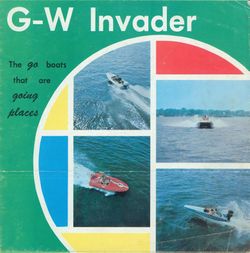
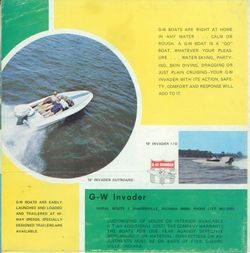
However, it’s in the first brochure we see the G-W Invader line of boats described as the “Go Boats” at least three times. There is also a great quote that went, “G-W on a boat is like sterling on silver – It makes G-W boats worth more…” and another on the back that is my favorite, “Whatever your pleasure, water-skiing, partying, skin diving, dragging or just plain cruising – Your G-W Invader with its action, safety, comfort and response will add to it.” Arnie’s creative flare is all over the first brochure along with great colors from the sixties
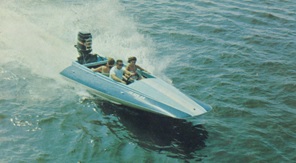
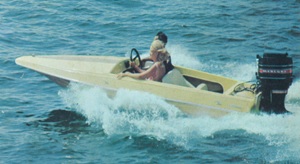
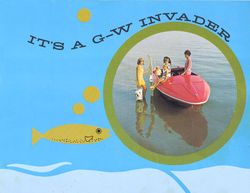
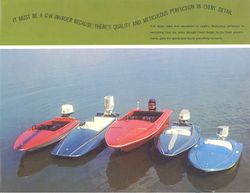
The last brochure of the Wooldridge era was a very nice six page brochure made of a higher quality material with high glossy pictures of the company’s lineup. The front cover is very interesting in that it includes two members of the Boice family (Joyce is the lady standing in the boat and DeeAnna is sitting on the edge of the boat). Also sitting in the back of the boat by the engine is George’s only child Anita. G-W Invader basically built four models in the late sixties that were the main stay of the company. The original 10’, 14’ V hull, 15’ V hull and a 15’ tunnel hull. This brochure also promotes a 19’ V hull with taller gunnels, but only a very limited number of these boats were built. However, in keeping with the high performance theme, a few of the 19’ V hulls were powered with the legendary L88 Corvette engine and used the newly designed Berkley jet drive. This brochure pushes the 14’, 15’, 19’ V hulls and the 15’ tunnel hull extensively and only has a few shots of the very successful Ten-footer. In some ways it feels like G-W was trying to persuade all the owners (young adults or kids) of the Ten-footer, to move up to its larger line of boats, but yet keep that racy feel and look the brand had come to represent. G-W owners were about to grow up from the toy like Ten-footer to seriously fast race boats. The brochure dedicates the entire back page to its new racing campaign as the company changes direction.
Besides the “Ten-footer” success, the 14’ V hull was a very popular model due again to its high horsepower rating and high speed. The boat had a sleek design for its time, was sturdy for the beatings it took on local lakes and race courses.
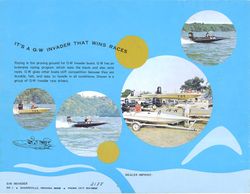
The 15’ V hull was an attempt to make a larger and roomier cockpit than the 14’, plus the extra foot allowed for an even higher horsepower rating. However, the extra foot caused the 15’ boat to be a little slower than the 14’ at the time. Not until later in the nineties when stepping back the motors came along, did the performance of the boat improve for the very few who still owned these models. The 15’ Tunnel hull was an attempt to incorporate the new high speed tunnel hull race boats of the sixties with the seating capacity of four, like the 15’ V hull. Although, this sounded like another great idea by G-W, the boat was notorious for nose diving or “submarining” while washing all occupants and belongings from the boat. Not a fun way to spend your Saturday afternoon with the wife and kids in the “Go” boat. Nevertheless, the 15’ tunnel hull was raced with limited success. There are some great photos on the back of the second brochure that show G-W boats racing and a testimonial that describes racing as a proving ground. Besides the “Ten-footer” all other models from the late sixties are extremely hard to find today in original condition.
At the time of construction for these boats, balsa core was the high technology of the time. Balsa core is simply balsa wood, cut against the grain into quarter inch thickness, split into tiny cubes and then glued to a binder mat. It was very flexible, lightweight, strong when laminated with fiberglass and used throughout the FRP industry at the time. However, once the balsa got wet for whatever reason under the fiberglass, nature took its course and rot ensued. Another factor that gave strength to the boats in the sixties would be the downfall to the surviving hulls of today. All of the original G-W Invader boats from the sixties had the deck and associated hull “fiber-glassed” together, making separation nearly impossible or extremely difficult. As normal wood transoms rotted out over the course of forty plus years, many boats succumb to the dump as the cost to fix correctly was simply not worth it.
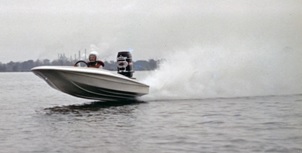
The initial lineup in 1967 included three models, but by the end of 1969 there were over fifteen different models available. None saw the incredible sales success as the “Ten-footer” however one model, the 14’ V Hull saw success on a different level and Mercury Marine took notice! On August 9, 1968 a G-W Invader “14-footer”, powered by a Mercury 100 hp BP engine, driven by Gary Garbrecht, at less than 800 lbs. net running weight with driver, ran a top speed of 78.4 mph on Lake Butte des Morts in Oshkosh, WI. Now with Mercury Marine as a factory sponsor, Wooldridge saw the possibility of setting a speed record and a chance to make history. The team at G-W went back to work and built a new lighter weight boat. On August 26, 1968 the boat set an N.O.A. unlimited one class speed record over a measured course at a speed of 79.646 mph! This triumph impacted G-W Invader significantly and changed the direction of the company. Now along with building the fun, kid friendly “Ten-footer” the company aggressively enacted a serious racing campaign with Mercury’s help. No one was bit harder by the “race bug” than George Wooldridge and the company’s lineup reflected this passion. George would spend the remainder of his life in one fashion or another designing and building fiberglass race boats. A G-W driven by Jim Flood would even carry the coveted 1-US for being high points champion in its class for 1967 and 1968.
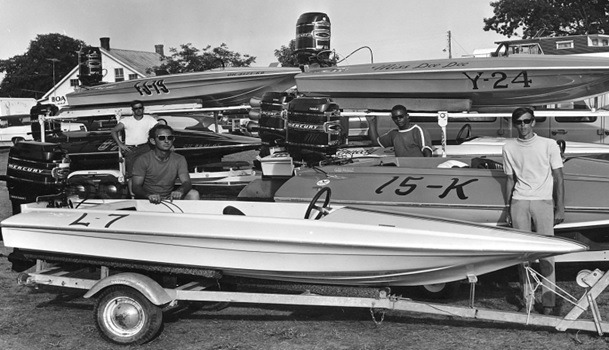

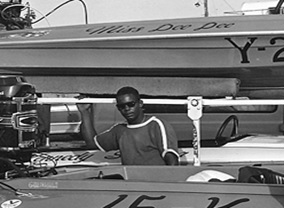
Art Kennedy - Or “Butch” as he was better known was one of the all-time great G-W Invader race boat drivers. His father was a legendary racer from St. Louis and Butch followed in his footsteps. This kind and gentle man was a proud supporter of G-W invader at race sites and boat shows. However, on the race course he was a gifted driver, who knew how to time a start just right, make a V bottom hull turn like no other and still bring back the trophy with a friendly smile on his face. Mercury Marine race director Bill Welch said, “no one drove a 14-foot G-W like Butch”. Art lived in a time of extreme racism in the southern United States and faced its wrath often. Whether that was trying to get a hotel room in Arkansas or accepting a winning trophy from a Governor who would not shake his hand, he continued to rise above it all. He was very close to the Boice family and even named his successful 14’ Y-24 G-W hull “Miss Dee Dee” after Bill Boice’s young daughter DeeAnna.
It goes without saying that the designs created by G-W Invader during these years were simply remarkable for their time. One only needs to Goggle search G-W Invader for stories and images to see how these boats still impact so many people. The company produced several sleek, fast and exciting boats, but none that fueled the imagination of a youngster like a “Ten-footer”. It had the lines of a race boat, was user friendly enough for a kid and still had plenty of speed to imitate the thrill of racing. The combination of a great boat and innovative marketing would propel the company to a level of success that none could have ever imagined in the little farm town of Sharpsville. Without a doubt the “Ten-footer” made the G-W Invader brand famous and would give the company an identity that is even strong today! Just attend any antique boat show today and the crowd is usually standing around a G-W Invader “Ten-footer” with the same smiles they had nearly 50 years ago.
Jan 1970 – To the surprise of most, George sold the company to the Todd Group, a company out of New York that was managed by Bruce Gordon. Most believe the financial stress that came along with running the company finally became too much for George and he decided to sell, but would quickly regret that decision. This decision forced the remaining owners to move on and only Bill Boice remained as an employee with the new company, but only for three more months. By the end of March 1970, all the founding fathers of G-W Invader were gone and so was an incredible chapter in the company’s history. George would eventually return, but it would never be the same.
The new owners produced a small 10 page color brochure touting four of the original designs by Arnie and George. They also included three traditional runabouts, a fish-n-ski hull, an I/O version of the original 19’ V hull and a new 13’ hull called the Banchie. The brochure though small, had a fantastic photo on its cover of five “Ten-footers” launching over ramps, through colored balloons at Cypress Gardens in Florida. The original sales slogan of the “Go Boats” was dropped for a new slogan “The Outperformers”.
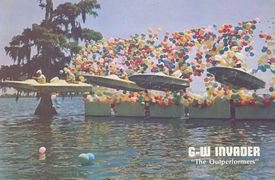
It’s believed that the Todd Group really had no interest in building boats and trying to run the company from New York proved to be very difficult. The new owners really wanted to take the Todd Group public and by owning a successful, exciting boat brand like G-W Invader, they hoped this would help them reach that goal. Evidence of this plan can be seen in many of the advertisements of that time. Full page adds in popular magazines, touted owning a G-W Invader as being part of the “in crowd”. The magazine ads compared owning a G-W Invader boat to owning an exotic car brand, like Ferrari, Jaguar, Maserati and Porsche.
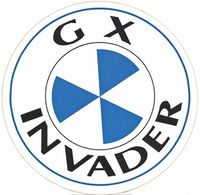
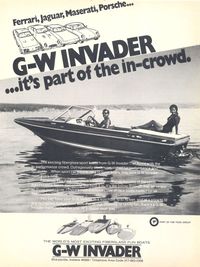
The new owners only made slight modifications to the four original hulls, giving the models generic names, adding windshields and different seats. The “Ten-footer” was spared most of the embarrassing changes and only got new bucket seats. Apparently, the Todd Group did not want to mess with the standard bearer of the company lineup. Of note, the traditional metal chrome “G-W Invader” emblem on both sides of all the boats was dropped off for a cheap white decal. This came to be symbolic of the sad transition the boat line would go through over the next three years. An October 1971 article in the Tipton Tribune announced a name change to GX Invader. According to the article the move was motivated by a desire to avoid confusion with the names of other manufacturers. It also goes on to state that the company had 180 dealers in 38 states. Due to legal issues, the name “G-W Invader” would cease to exist for over two decades before the brand would once again reemerge in the late eighties.
This was the beginning of darker days for the once proud lineup and a slow ending for many years of fantastic designs and styling. The changes to the boats and additional models made the brand similar to most other manufacturers on the market and it tarnished the company’s image. As the Todd Group saw that GX Invader was not going to propel them into a public traded company, they simply halted production and the doors to the plant were closed. All these factors only drove Georges resolve, to get the company back in his ownership and to hopefully revive the once proud brand. George still owned the plant and leased it to the Todd Group, so after waiting a legal amount of time, the plant and its inventory would simply be back in his hands.
Meanwhile, George spent this time working with Bob Sanders in a garage across the street from the plant on his next designs. Bob was from Louisiana, raced the 14’ V hull and had spent time at the factory trying to improve the 14’ V hull. It was during this time that George and Bob developed the last high performance V bottom hull. A very light weight racing 13’ V hull that would take advantage of OMC’s new three cylinder “Stinger” engine. The hull was incredibly fast and only one complete boat is known to still exist today.
March 1973 – Eventually George Wooldridge finally regained ownership of the Sharpsville plant but was forced to rename the company Delta Marine. He built mainly bass boats, deck boats and the original ten-footer that made the company famous, when there was a customer request. George struggled for the remainder of his life, to revive the once proud brand name, but to no avail. The racing bug that had bit him in the late sixties had never stopped impacting him as he continued to build tunnel hulls and race boats on the side. However, the company would never again see the prominence it had in the boat racing world. Delta’s entry in the consumer bass boat market seemed even more daunting. Competitors like Ranger, with vast capital and resources, spelled doom for the small boat builder in Indiana. George entered the outboard deck boat market but again he felt competition from the Indiana boat giant Viking. The Northern part of Indiana became a haven for successful boat manufacturers like Rinker, Formula and many others with deep pockets and a plentiful labor force. In desperation Delta began building shower stalls, fiberglass sleighs and even a cross between a boat and canoe, simply called the “Bonoe”. As the company struggled so did George’s health. The stress of trying to revive the company would eventually take his life.
The one bright spot for George during this time period was the introduction of a young 16 year old boy, who shared George’s incredible passion for G-W Invader boats. Although George did not have a birth son of his own, he considered the young Roger Harmon his boy. Under George’s wing Roger learned the art and craft of building fiberglass boats. It would be this last major act by the “boat builder” that would eventually breathe life back into the proud G-W Invader name, many years later!
June 1981 – George dies as his desk, in the office of the company he started in the quiet rural farm town of Sharpsville. Roger Harmon and George’s wife Schatze rushed together to the hospital only to learn of his fate. Sitting quietly crying in a hospital hallway, Roger vowed to bring the little boat company back to the prominence his mentor once knew. George’s widow eventually leased the buildings to another businessman and he struggled to continue the Delta brand until its final collapse in early 1985. The buildings and plant fell into complete disarray. The once proud facility was surrounded by trash, leaking roofs, junk boats, over grown weeds and was dying a slow death. However there was hope, in a small pole barn not more than three miles away, the young determined Roger Harmon was making his plans to bring G-W Invader back to life…..
Written by Marc Diller
G-W INVADER – The Harmon Era
To be continued…..
About the Author
It was the summer of 1976 on busy Lake Shafer in Monticello, Indiana and my parents had taken me to the local sand bar for a long afternoon of fun in our aqua colored Rinker runabout. As they laughed with old friends and family, I spent my time like most normal eight year old kids who were at the beach, digging in the sand with my cousin. I could hear my father yell as it was time to go home, but I choose to ignore him as I did not want to stop playing. Finally, my father got close enough to say, “come on, you’re going to want to see what a friend wants to sell me”. A short boat ride later, we gazed upon a small two passenger boat, with a white hull, a slightly faded red deck, two white seats and a blue 1950’s Evinrude 35 hp outboard motor, sitting in an old Shore Station boat lift. Glistening in the sun on the back corner of the faded red deck was a small shiny emblem that simply said “G-W Invader”. The rest as they say is history and my life would be forever changed…
Special Thanks to all of those who contributed to this story and specifically to the names below:
Bill Boice and Family
Roger Harmon
Diana Gray Watson
Bill Welch
Comments or additional information that adds to the G-W Invader story can be sent to Marc Diller at md3149@frontier.com.



